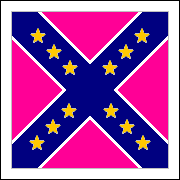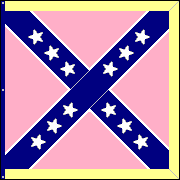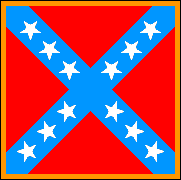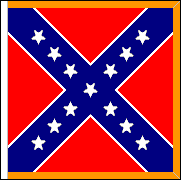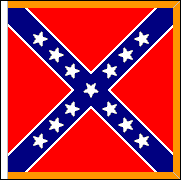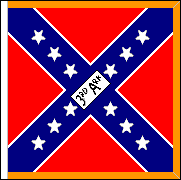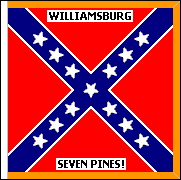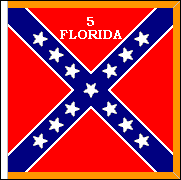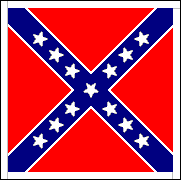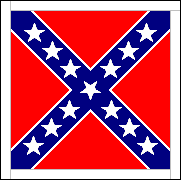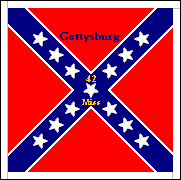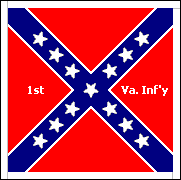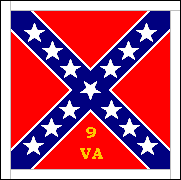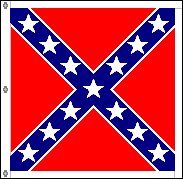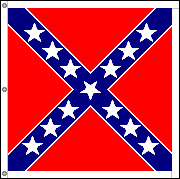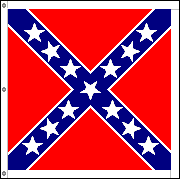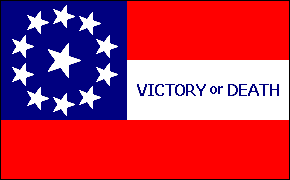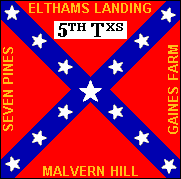CONFEDERATE STATES OF AMERICA
BATTLE FLAGS OF THE ARMY OF NORTHERN VIRGINIA
Images Added February 2011
3rd Arkansas Infantry • 4th North Carolina Infantry • 1st Virginia Infantry • 4th & 5th Texas Infantry
The battle flag adopted in late 1861 for Confederate troops in the Virginia theater was destined to gain fame as the most recognizable symbol of the Southern cause. It was designed by William P. Miles, an officer on the staff of General G.T. Beauregard. Experience had shown that the first Confederate States national flag, known as the Stars and Bars, was unsuitable for battlefield use because of its resemblance to the US Stars and Stripes. To remedy this problem, Beauregard suggested the creation of a "battle flag" specifically for army use, and after some discussion Miles' design was accepted.
The basic design of what became known as the Army of Northern Virginia Battle Flag was a blue, white-bordered saltire cross on a red field. Placed on the arms of the cross were stars symbolizing the states of the Confederacy. The first prototypes, sewn by patriotic ladies of Richmond, Virginia, were made of silk, had gold stars, and were ornamented with fringe. Once the design was approved, the Confederate Army's Quartermaster General began purchasing silk for the new battle flags. which were actually produced by ladies' sewing circles.
To save materials, the new battle flag was to be made square. Originally, three sizes were specified: 48 inches square for the infantry, 36 inches square for the artillery, and 30 inches for the cavalry. The silk issues, however, were made in one size only—48 inches—and subsequent issues were often distributed to units without regard to size. In all, there were two silk issues, one cotton issue and seven bunting issues of the ANV Battle Flag.
Though the ANV Battle Flag was produced and issued in large numbers, it never completely replaced the flags of earlier patterns carried by various regiments, particularly those from the western states of the Confederacy. Some units of Hood's Texas Brigade, for example, continued to use battle flags based on the Texas state flag, the First National Flag, or privately produced flags based on the ANV pattern.
Credit: The text and drawings on this page are based on information from Devereaux Cannon's FOTC Flags of the Confederacy website.
|
FIRST SILK ISSUE |
SECOND SILK ISSUE |
|
|
|
|
COTTON ISSUE |
|
|
|
|
|
FIRST BUNTING ISSUE |
SECOND BUNTING ISSUE |
|
|
|
|
3rd ARKANSAS INFANTRY |
4th NORTH CAROLINA INFANTRY |
5th FLORIDA INFANTRY |
|
|
|
|||
|
THIRD BUNTING ISSUE |
FOURTH BUNTING ISSUE |
||
|
|
|||
|
42nd MISSISSIPPI INFANTRY |
1st VIRGINIA INFANTRY |
9th VIRGINIA INFANTRY |
|
|
|
|||
|
FIFTH BUNTING ISSUE |
SIXTH BUNTING ISSUE |
||
|
|
|||
|
SEVENTH BUNTING ISSUE |
|||
|
|
|||
|
4th TEXAS INFANTRY |
5th TEXAS INFANTRY |
||
|
|
|||
